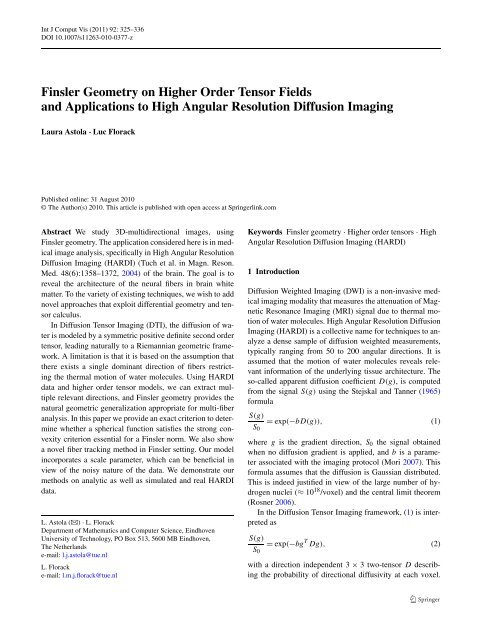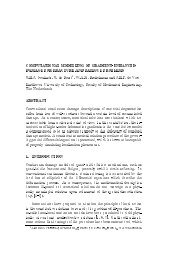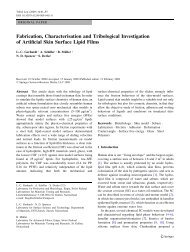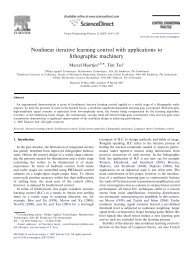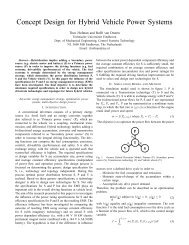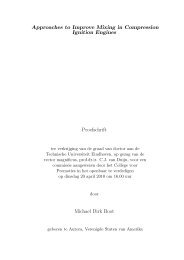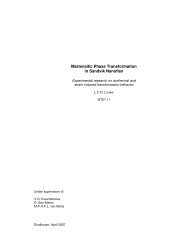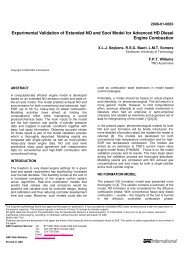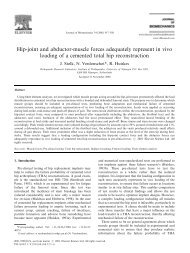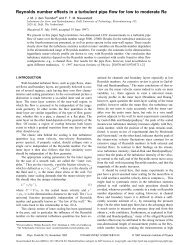Finsler Geometry on Higher Order Tensor Fields - Materials ...
Finsler Geometry on Higher Order Tensor Fields - Materials ...
Finsler Geometry on Higher Order Tensor Fields - Materials ...
Create successful ePaper yourself
Turn your PDF publications into a flip-book with our unique Google optimized e-Paper software.
Int J Comput Vis (2011) 92: 325–336DOI 10.1007/s11263-010-0377-z<str<strong>on</strong>g>Finsler</str<strong>on</strong>g> <str<strong>on</strong>g>Geometry</str<strong>on</strong>g> <strong>on</strong> <strong>Higher</strong> <strong>Order</strong> <strong>Tensor</strong> <strong>Fields</strong>and Applicati<strong>on</strong>s to High Angular Resoluti<strong>on</strong> Diffusi<strong>on</strong> ImagingLaura Astola · Luc FlorackPublished <strong>on</strong>line: 31 August 2010© The Author(s) 2010. This article is published with open access at Springerlink.comAbstract We study 3D-multidirecti<strong>on</strong>al images, using<str<strong>on</strong>g>Finsler</str<strong>on</strong>g> geometry. The applicati<strong>on</strong> c<strong>on</strong>sidered here is in medicalimage analysis, specifically in High Angular Resoluti<strong>on</strong>Diffusi<strong>on</strong> Imaging (HARDI) (Tuch et al. in Magn. Res<strong>on</strong>.Med. 48(6):1358–1372, 2004) of the brain. The goal is toreveal the architecture of the neural fibers in brain whitematter. To the variety of existing techniques, we wish to addnovel approaches that exploit differential geometry and tensorcalculus.In Diffusi<strong>on</strong> <strong>Tensor</strong> Imaging (DTI), the diffusi<strong>on</strong> of wateris modeled by a symmetric positive definite sec<strong>on</strong>d ordertensor, leading naturally to a Riemannian geometric framework.A limitati<strong>on</strong> is that it is based <strong>on</strong> the assumpti<strong>on</strong> thatthere exists a single dominant directi<strong>on</strong> of fibers restrictingthe thermal moti<strong>on</strong> of water molecules. Using HARDIdata and higher order tensor models, we can extract multiplerelevant directi<strong>on</strong>s, and <str<strong>on</strong>g>Finsler</str<strong>on</strong>g> geometry provides thenatural geometric generalizati<strong>on</strong> appropriate for multi-fiberanalysis. In this paper we provide an exact criteri<strong>on</strong> to determinewhether a spherical functi<strong>on</strong> satisfies the str<strong>on</strong>g c<strong>on</strong>vexitycriteri<strong>on</strong> essential for a <str<strong>on</strong>g>Finsler</str<strong>on</strong>g> norm. We also showa novel fiber tracking method in <str<strong>on</strong>g>Finsler</str<strong>on</strong>g> setting. Our modelincorporates a scale parameter, which can be beneficial inview of the noisy nature of the data. We dem<strong>on</strong>strate ourmethods <strong>on</strong> analytic as well as simulated and real HARDIdata.L. Astola () · L. FlorackDepartment of Mathematics and Computer Science, EindhovenUniversity of Technology, PO Box 513, 5600 MB Eindhoven,The Netherlandse-mail: l.j.astola@tue.nlL. Floracke-mail: l.m.j.florack@tue.nlKeywords <str<strong>on</strong>g>Finsler</str<strong>on</strong>g> geometry · <strong>Higher</strong> order tensors · HighAngular Resoluti<strong>on</strong> Diffusi<strong>on</strong> Imaging (HARDI)1 Introducti<strong>on</strong>Diffusi<strong>on</strong> Weighted Imaging (DWI) is a n<strong>on</strong>-invasive medicalimaging modality that measures the attenuati<strong>on</strong> of MagneticRes<strong>on</strong>ance Imaging (MRI) signal due to thermal moti<strong>on</strong>of water molecules. High Angular Resoluti<strong>on</strong> Diffusi<strong>on</strong>Imaging (HARDI) is a collective name for techniques to analyzea dense sample of diffusi<strong>on</strong> weighted measurements,typically ranging from 50 to 200 angular directi<strong>on</strong>s. It isassumed that the moti<strong>on</strong> of water molecules reveals relevantinformati<strong>on</strong> of the underlying tissue architecture. Theso-called apparent diffusi<strong>on</strong> coefficient D(g), is computedfrom the signal S(g) using the Stejskal and Tanner (1965)formulaS(g)= exp(−bD(g)), (1)S 0where g is the gradient directi<strong>on</strong>, S 0 the signal obtainedwhen no diffusi<strong>on</strong> gradient is applied, and b is a parameterassociated with the imaging protocol (Mori 2007). Thisformula assumes that the diffusi<strong>on</strong> is Gaussian distributed.This is indeed justified in view of the large number of hydrogennuclei (≈ 10 18 /voxel) and the central limit theorem(Rosner 2006).In the Diffusi<strong>on</strong> <strong>Tensor</strong> Imaging framework, (1) is interpretedasS(g)S 0= exp(−bg T Dg), (2)with a directi<strong>on</strong> independent 3 × 3 two-tensor D describingthe probability of directi<strong>on</strong>al diffusivity at each voxel.
326 Int J Comput Vis (2011) 92: 325–336A natural way to do geometric analysis <strong>on</strong> the image, isto use the inverse of the diffusi<strong>on</strong> tensor D as the Riemannmetric tensor. The heuristic for this is that large diffusi<strong>on</strong>implies short travel time (distance) for an ensembleof diffusing particles. This approach has been exploited tosome extent in the DTI literature (O’D<strong>on</strong>nell et al. 2002;Lenglet et al. 2004; Astolaetal.2007; Astola and Florack2008; Fuster et al. 2009). Since HARDI data typically c<strong>on</strong>tainsmore directi<strong>on</strong>al measurements than DTI, it requiresa model that has richer directi<strong>on</strong>al informati<strong>on</strong> than a localpositi<strong>on</strong> dependent inner product i.e. Riemannian metric.<strong>Higher</strong> order tensor representati<strong>on</strong>s (Özarslan and Mareci2003; Barmpoutis et al. 2007; Florack and Balmashnova2008) form an interesting alternative to the popular sphericalharm<strong>on</strong>ic representati<strong>on</strong> of HARDI data and this is especiallysuited for a <str<strong>on</strong>g>Finsler</str<strong>on</strong>g> geometric approach. <str<strong>on</strong>g>Finsler</str<strong>on</strong>g> geometryhas already been c<strong>on</strong>sidered for HARDI analysis inMel<strong>on</strong>akos et al. (2008), where the necessary homogeneityc<strong>on</strong>diti<strong>on</strong> is imposed <strong>on</strong> the <str<strong>on</strong>g>Finsler</str<strong>on</strong>g> norm by definiti<strong>on</strong>. InSMel<strong>on</strong>akos et al. (2008) a third power of a ratioFR(S/S 0 ) ofthe signal S and the Funk-Rad<strong>on</strong> transform of the attenuati<strong>on</strong>FR(S/S 0 ) is used as the cost functi<strong>on</strong>, and the optimalpaths that minimize geodesic distances w.r.t. this cost functi<strong>on</strong>are computed using dynamic programming.In this paper a different approach is proposed, usinghigher order m<strong>on</strong>omial tensors to approximate the sphericalfuncti<strong>on</strong>s that represent the complex diffusi<strong>on</strong>/fiber orientati<strong>on</strong>profiles, such as the orientati<strong>on</strong> distributi<strong>on</strong> functi<strong>on</strong>(ODF), and c<strong>on</strong>structing a homogeneous <str<strong>on</strong>g>Finsler</str<strong>on</strong>g> norm fromthese. Fibers are not modeled here as geodesics. For examplethe subcortical fibers, having high curvature but modestanisotropy, cannot be modeled as geodesics neither w.r.t.the Riemann metric (D −1 ) nor the <str<strong>on</strong>g>Finsler</str<strong>on</strong>g> norm we proposehere. Instead, the streamline tractography, comm<strong>on</strong>ly usedin DTI, is generalized here to the HARDI case.This paper is organized as follows. Secti<strong>on</strong> 2 c<strong>on</strong>tains avery short introducti<strong>on</strong> to <str<strong>on</strong>g>Finsler</str<strong>on</strong>g> geometry and in Sect. 3 weverify that indeed HARDI measurements can be modeledwith a <str<strong>on</strong>g>Finsler</str<strong>on</strong>g>-structure and give a specific c<strong>on</strong>diti<strong>on</strong> whichensures this. In Sect. 4 an explicit method to transforma polynomial tensor presentati<strong>on</strong>, which allows Laplace-Beltrami smoothing, to a m<strong>on</strong>omial <strong>on</strong>e c<strong>on</strong>venient for c<strong>on</strong>structinga <str<strong>on</strong>g>Finsler</str<strong>on</strong>g>-norm is given. In Sect. 5 we show someresults of <str<strong>on</strong>g>Finsler</str<strong>on</strong>g> fiber-tracking <strong>on</strong> simulated data sets aswell as <strong>on</strong> two human brain HARDI data. In the appendixwe show the details of computing the new str<strong>on</strong>g c<strong>on</strong>vexitycriteri<strong>on</strong>.2 <str<strong>on</strong>g>Finsler</str<strong>on</strong>g> <str<strong>on</strong>g>Geometry</str<strong>on</strong>g>In a perfectly homogeneous and isotropic medium, geometryis Euclidean, and shortest paths are straight lines.In an inhomogeneous space, geometry is Riemannian andthe shortest paths are geodesics induced by the Levi-Civitac<strong>on</strong>necti<strong>on</strong> (Carmo 1993). The Levi-Civita c<strong>on</strong>necti<strong>on</strong> is aset of rules that tells <strong>on</strong>e how to take derivatives <strong>on</strong> a Riemannianmanifold. If the c<strong>on</strong>necti<strong>on</strong> is linear, symmetricand satisfies the product (Leibniz) rule, then it is unique.If a medium is not <strong>on</strong>ly inhomogeneous, but also anisotropic,1 i.e. it has an innate directi<strong>on</strong>al structure, the appropriategeometry is <str<strong>on</strong>g>Finsler</str<strong>on</strong>g>ian (Bao et al. 2000; Shen2001) and the shortest paths are corresp<strong>on</strong>dingly <str<strong>on</strong>g>Finsler</str<strong>on</strong>g>geodesics.As a c<strong>on</strong>sequence of the anisotropy, the metrictensor (to be defined below) depends <strong>on</strong> both positi<strong>on</strong> anddirecti<strong>on</strong>. This is also a natural model for high angular resoluti<strong>on</strong>diffusi<strong>on</strong> images.Another way to look at the difference of Riemann and<str<strong>on</strong>g>Finsler</str<strong>on</strong>g> geometry is that while Riemannian distances are definedby a positi<strong>on</strong> dependent inner product, <str<strong>on</strong>g>Finsler</str<strong>on</strong>g>ian distancesare defined by a directi<strong>on</strong> dependent inner product,computed from a positi<strong>on</strong> dependent norm. Since the levelsets determined by norms can be more complex than those(ellipsoidal) given by an inner product, this approach is suitablefor modeling complex diffusi<strong>on</strong> profiles.Definiti<strong>on</strong> 1 Let M be a differentiable manifold and T x Mbe a (Euclidean) tangent space (approximating the manifoldat each point) at x ∈ M. LetTM= ⋃ x∈M T xM be the collecti<strong>on</strong>of tangent spaces. Take y to be a vector with positivelength in T x M. A <str<strong>on</strong>g>Finsler</str<strong>on</strong>g> norm is a functi<strong>on</strong> F : TM →[0, ∞) that satisfies each of the following criteria:1. Differentiability: F(x,y) is C ∞ <strong>on</strong> TM.2. Homogeneity: F(x,λy)= λF (x, y).3. Str<strong>on</strong>g c<strong>on</strong>vexity: The <str<strong>on</strong>g>Finsler</str<strong>on</strong>g> metric tensor, derived fromthe <str<strong>on</strong>g>Finsler</str<strong>on</strong>g> norm, with comp<strong>on</strong>entsg ij (x, y) = 1 ∂ 2 F 2 (x, y)2 ∂y i ∂y j , (3)is positive definite at every point (x, y) of TM.√Note that if F(x,y) = g ij (x)y i y j , then g ij (x, y) = g ij (x)i.e. it reduces to a Riemannian metric.3 <str<strong>on</strong>g>Finsler</str<strong>on</strong>g> Norm <strong>on</strong> HARDI <strong>Higher</strong> <strong>Order</strong> <strong>Tensor</strong> <strong>Fields</strong>We want to show that higher order tensors, such as thosefitted to HARDI data, do define a <str<strong>on</strong>g>Finsler</str<strong>on</strong>g> norm, which can1 We will call a medium isotropic if it is endowed with a directi<strong>on</strong> independentinner product, or Riemannian metric. In the literature sucha medium is also often referred to as anisotropic due to the directi<strong>on</strong>albias of the metric itself.
Int J Comput Vis (2011) 92: 325–336 327be used in the geometric analysis of this data. We take as apoint of departure a given orientati<strong>on</strong> distributi<strong>on</strong> functi<strong>on</strong>(ODF), which if normalized, is a probability density functi<strong>on</strong><strong>on</strong> the sphere. Such a spherical functi<strong>on</strong>, assigning unitvectors a probability that it coincides with fiber- or diffusi<strong>on</strong>orientati<strong>on</strong>s, can be computed from HARDI data byusing <strong>on</strong>e of the methods described in the literature (Tuch2004; Jans<strong>on</strong>s and Alexander 2003; Özarslan et al. 2006;Jian et al. 2007; Descoteaux et al. 2006). The ODF is assumedto be symmetric w.r.t. the origin i.e. an even orderfuncti<strong>on</strong>. A higher order symmetric tensor restricted tothe sphere, can be defined as follows. Let y be a unit vectory(θ, ϕ) = (u(θ, ϕ), v(θ, ϕ), w(θ, ϕ))= (sin θ cos ϕ,sin θ sin ϕ,cos θ). (4)It is well known that every even order real spherical polynomialup to order l can be represented as a linear combinati<strong>on</strong>of the spherical harm<strong>on</strong>ics basisY0 0 −2(θ, ϕ), Y2 (θ,ϕ),...,Yl l−1 (θ, ϕ), Yl l (θ, ϕ). (5)In tensor formulati<strong>on</strong> we use the following basis (omittingthe arguments (θ, ϕ))u l ,u l−1 v 1 ,u l−1 w 1 ,...,u p v q w r ,...,w l (6)where p + q + r = l. For simplicity we c<strong>on</strong>sider fourthorder tensors (l = 4) in what follows, but any even ordertensor can be treated in similar way.We denote a fourth order symmetric tensor (using theEinstein summati<strong>on</strong> c<strong>on</strong>venti<strong>on</strong>, i.e. a i b i = ∑ i a ib i )as,T(x,y) = T ij kl (x)y i y j y k y l . (7)We fit such a tensor to the ODF-data, using linear leastsquares method, following Özarslan and Mareci (2003).Suppose we obtain measurements m 1 ,m 2 ,...,m N in N differentdirecti<strong>on</strong>s. First we recall that the number of distinctnth order m<strong>on</strong>omials of 3 variables (u, v and w)is(3 + n − 1)!. (8)(3 − 1)!n!Thus a fourth order symmetric tensor is completely determinedby 15 coefficients. We denote the multinomial coefficientasμ(û, ˆv,ŵ) =(û +ˆv +ŵ)!, (9)(û!ˆv!ŵ!)where û +ˆv + ŵ = 4 and û denotes the multiplicity ofcomp<strong>on</strong>ent u etc. We omit zero multiplicities from notati<strong>on</strong>μ(0, ˆv,0) = μ(ˆv). To fit tensor (7) to data, first the following(N × 15) matrix M is c<strong>on</strong>structed:⎛⎞μ(4)u 4 1 μ(3, 1)u 3 1 v 1 ... μ(2, 2)v1 2w2 1 ... μ(4)w14 μ(4)u 4 2 μ(3, 1)u 3 2 v 2 ... μ(2, 2)v2 2w2 2 ... μ(4)w 4 2⎜⎝ ..,.. ⎟⎠μ(4)u 4 N μ(3, 1)u 3 N v N ... μ(2, 2)vN 2 w2 N ... μ(4)wN4(10)where u i = u(θ i ,ϕ i ), v i = v(θ i ,ϕ i ), etc. corresp<strong>on</strong>ding tothe ith measurement. Setting the unknown tensor coefficientsto be d 1 ,d 2 ,d 3 ,...,d 15 and defining vectors⎛⎛d 1m 1⎜ ⎟⎜ ⎟⎞d 2d =⎜ .⎝ .⎟⎠d 15⎞m 2and m =⎜ ., (11)⎝ .⎟⎠m Nwe can solve d from the equati<strong>on</strong>M · d = m, (12)using the pseudo-inverse.Next we define a <str<strong>on</strong>g>Finsler</str<strong>on</strong>g> norm F(x,y) corresp<strong>on</strong>ding tofourth order ODF-tensor asF(x,y) = (T ij kl (x)y i y j y k y l ) 1/4 . (13)A general form for any even order n would be thenF(x,y) = (T i1 ...i n(x)y i1 ···y i n) 1/n . (14)In the following, we verify the necessary criteria for this(13) to be a <str<strong>on</strong>g>Finsler</str<strong>on</strong>g> norm in Definiti<strong>on</strong> 1.1. Differentiability: The tensor field T (x,y) is c<strong>on</strong>tinuousin x by linear interpolati<strong>on</strong> between the sample pointsand differentiable w.r.t. x using Gaussian derivatives.As a probability T(x,y) is assumed to be n<strong>on</strong>-negative,and the differentiability of F(x,y) w.r.t. x follows. Thedifferentiability of F(x,y) in y is obvious from the formula(13).2. Homogeneity: Indeed for any α ∈ R + , x ∈ MF(x,αy) = (T ij kl (x)αy i αy j αy k αy l ) 1/4= αF(x,y). (15)3a. Str<strong>on</strong>g c<strong>on</strong>vexity for a tensor based norm: Since this isa pointwise criteri<strong>on</strong>, we omit here the argument x. Wecompute explicitly the metric tensor from norm (13)g ij (y) = 1 ∂ 2 F 2 (y)2 ∂y i ∂y j
328 Int J Comput Vis (2011) 92: 325–336= 3T −1/2 T ij kl y k y l− 2T −3/2 T iabc y a y b y c T jpqr y p y q y r , (16)where we have abbreviated the scalar sum asT ij kl y i y j y k y l := T . To simplify the expressi<strong>on</strong>, wemultiply it with a positive scalar c = T 3/2 , since it doesnot affect the positive definiteness. We obtainc · g ij (y) = 3TT ij kl y k y l− 2T iabc y a y b y c T jpqr y p y q y r . (17)We define a special product inner product candidate〈v,v〉 T := T ij kl y k y l v i v j . (18)Then from (17) we have for an arbitrary vector v:c · g ij (y)v i v j =〈y,y〉 T 〈v,v〉 T + 2 ( 〈y,y〉 T 〈v,v〉 T−〈y,v〉 T 〈y,v〉 T). (19)In case (18) does define an inner product, the Cauchy-Schwarz inequality says that the last term must be n<strong>on</strong>negative.Then we have indeed thatg ij (y)v i v j > 0. (20)Thus in case the norm functi<strong>on</strong> is a power of an even ordertensor, the str<strong>on</strong>g c<strong>on</strong>vexity is satisfied if the 〈,〉 T ispositive, since it meets all other c<strong>on</strong>diti<strong>on</strong>s for an innerproduct. As a result the original c<strong>on</strong>diti<strong>on</strong> for positivedefinitenessg ij (y)v i v j = (T −1/2 T ij kl y k y l− 2T −3/2 T iabc y a y b y c T jpqr y p y q y r )v i v j> 0 (21)We denote v θ :=∂θ ∂ (v), v θθ := ∂2 (v) and similarly∂θ 2for ϕ. We define the following three matrices:⎛v 1 v 2 v 3 ⎞m = ⎜ v⎝1 θv 2 θv 3 θ⎟⎠ ,v 1 ϕ v 2 ϕ v 3 ϕ⎛v 1 θθv 2 θθv 3 ⎞θθm θ = ⎜ v⎝θv 2 θv 3 ⎟θ ⎠ ,(25)⎛v 1 ϕϕ v 2 ϕϕ v 3 ⎞ϕϕm ϕ = ⎜ v⎝θv 2 θv 3 θ⎟⎠ .v 1 ϕ v 2 ϕ v 3 ϕv 1 ϕ v 2 ϕ v 3 ϕThen the str<strong>on</strong>g c<strong>on</strong>vexity requires:det(m θ )det(m) < 0 and det(m ϕ )det(m) < −(g ij v i θ vj ϕ) 2, (26)g ij v i θ vj θa proof of which is provided in Appendix.The goal of this secti<strong>on</strong> was to define <str<strong>on</strong>g>Finsler</str<strong>on</strong>g> metric tensorsg ij (x, y) corresp<strong>on</strong>ding to a given tensorial ODF-field.Following a <str<strong>on</strong>g>Finsler</str<strong>on</strong>g> approach, instead of <strong>on</strong>e metric tensorper voxel <strong>on</strong>e obtains a collecti<strong>on</strong> of metric tensors at any x.For an illustrati<strong>on</strong>, see Fig. 1.is reduced to a simpler c<strong>on</strong>diti<strong>on</strong>T ij kl y k y l v i v j > 0. (22)3b. Str<strong>on</strong>g c<strong>on</strong>vexity for a general norm F :Wenowstatea str<strong>on</strong>g c<strong>on</strong>vexity criteri<strong>on</strong> for a general <str<strong>on</strong>g>Finsler</str<strong>on</strong>g> normF(x,y) in R 3 , by analogy to the R 2 -criteri<strong>on</strong> by Baoet al. (2000). We have put the derivati<strong>on</strong> of the c<strong>on</strong>diti<strong>on</strong>into Appendix, and merely state the result here.We c<strong>on</strong>sider the so-called indicatrix of the norm functi<strong>on</strong>F(x,y) at any fixed x, which is the set of vectorsv(θ, ϕ){v ∈ R 3 | F(v) = 1}. (23)The indicatrix forms a closed surface which is a unitsphere w.r.t. norm functi<strong>on</strong> F . When F is the Euclideanlength the indicatrix becomes the regular sphere.For brevity, we writev := v(θ, ϕ). (24)Fig. 1 (Color <strong>on</strong>line) A fourth order spherical tensor (the light purplecolored blob), representing an ODF and 2 ellipsoids illustrating thelocal sec<strong>on</strong>d order diffusi<strong>on</strong> tensors corresp<strong>on</strong>ding to the 2 vectors.The red ellipsoid is determined by the red vector and similarly for thegreen ellipsoid
Int J Comput Vis (2011) 92: 325–336 3294 Transforming a Polynomial <strong>Tensor</strong> to a M<strong>on</strong>omial<strong>Tensor</strong>Say we wish to regularize our spherical data, and that wewish to use a tensorial representati<strong>on</strong> of the data instead ofspherical harm<strong>on</strong>ics. In Florack (2008), a scale space extensi<strong>on</strong>for a spherical signal is c<strong>on</strong>sidered which is a generalizati<strong>on</strong>of the Tikh<strong>on</strong>ov regularizati<strong>on</strong>. This scale spacetakes particularly simple form when applied to spherical harm<strong>on</strong>ics(Bulow 2004). C<strong>on</strong>veniently, in Florack and Balmashnova(2008) it is shown that this regularizati<strong>on</strong> techniquecan also be applied to tensorial case requiring <strong>on</strong>lythat the tensor representati<strong>on</strong> is c<strong>on</strong>structed in a hierarchicalway, such that the higher order comp<strong>on</strong>ents c<strong>on</strong>tain <strong>on</strong>ly“residual” informati<strong>on</strong>, that can not be c<strong>on</strong>tained in lowerorder terms. In practice this means that to a given ODF, <strong>on</strong>efirst fits a zeroth order tensor, and to the residual <strong>on</strong>e fits asec<strong>on</strong>d order tensor. Further, <strong>on</strong>e fits iteratively higher ordertensors to the residuals until the desired order is reached(for details see Florack and Balmashnova 2008). However,as can be seen from the formulae below, it is not immediatelyclear how to homogenize a hierarchically expressedtensor, where higher order terms can have negative values.Thus for <str<strong>on</strong>g>Finsler</str<strong>on</strong>g> analysis, it is favorable to work with atensor representati<strong>on</strong> of m<strong>on</strong>omial formT(x,y) = T i1···i n(x)y i1 ···y i n, (27)and not with an equivalent polynomial expressi<strong>on</strong>T(x,y) =n∑˜T i1···i k(x)y i1 ···y i k, (28)k=0but to still benefit from the pointwise regularizati<strong>on</strong> schemeof the latter:T(x,y) τ =n∑e −τk(k+1) ˜T i1···i k(x)y i1 ···y i k, (29)k=0where τ is the regularizati<strong>on</strong> parameter.Indeed, we can transform a polynomial expressi<strong>on</strong> to am<strong>on</strong>omial <strong>on</strong>e using the fact that our polynomials are restrictedto the sphere (4), thus we may expand a nth ordertensor to a n + 2 order <strong>on</strong>e and symmetrize it. Symmetrizati<strong>on</strong>of a tensor amounts to a projecti<strong>on</strong> to the subspace ofsymmetric tensors (Yok<strong>on</strong>uma 1992). For an even order (2n)symmetric tensor T the multilinear mappingT : S 2 ×···×S 2} {{ }2n times→ R, T(y) = T i1 ...i 2ny i1 ···y i 2n, (30)can be equivalently expressed as a quadratic form˜T αβ ỹ α ỹ β , (31)where α, β = 1,...,3 n .Here ˜T is a square matrix withcomp<strong>on</strong>ents˜T αβ = T σα (i 1 )···σ α (i n )σ β (i 1 )···σ β (i n ), (32)andỹ α = y σ α(i 1) ···y σ α(i n ) , (33)where σ 1 ,...,σ 3 n are the permutati<strong>on</strong>s of comp<strong>on</strong>entsof y corresp<strong>on</strong>ding to each term of the outer producty ⊗ 1 ···⊗ n y.As an example to clarify the equivalence of (30) and (31),let us c<strong>on</strong>sider a spherical fourth order tensor A ij kl in dimensi<strong>on</strong>two, with input vectorsy = (y 1 , y 2 ) = (u(ϕ), v(ϕ)) = (cos ϕ,sin ϕ). (34)We observe that since the tensor is symmetric, a sumA ij kl y i y j y k y l (35)is equal to an inner product (omitting the argument ϕ here)⎛⎞A 1111 A 1112 A 1211 A 1212(u2uv vu v 2 ) ⎜A 1111 A 1112 A 1211 A 1212⎟⎝A 2111 A 2112 A 2211 A 2212⎠A 2121 A 2122 A 2221 A 2222⎛u 2 ⎞× ⎜uv⎟⎝vu⎠ . (36)v 2In this matrix-form, for example the expansi<strong>on</strong> of a sec<strong>on</strong>dorder tensor with comp<strong>on</strong>ents T ij to a fourth order tensorwith comp<strong>on</strong>ents T ij kl can be illustrated in a very simpleway in Fig. 2. Such expansi<strong>on</strong> is possible, because the inputvectors are unit vectors. For example we can immediatelyverify the following identity of a zeroth and a sec<strong>on</strong>d ordertensorc = ( u(ϕ) v(ϕ) ) ( )( )c 0 u(ϕ)= c(sin 2 ϕ + cos 2 ϕ).0 c v(ϕ)(37)The same principle extends to dimensi<strong>on</strong> three and higher.A formula for obtaining a fourth order symmetric tensorequivalent to a given sec<strong>on</strong>d order Cartesian tensor (i.e. thatT ij y i y j = T klmn y k y l y m y n ) is thusT ij kl = 1 ∑T σ(i)σ(j) I σ(k)σ(l) , (38)4!σ ∈S 4where I is the identity matrix and S 4 the symmetric group ofall permutati<strong>on</strong>s of a set of four elements.
330 Int J Comput Vis (2011) 92: 325–336Similar to the Riemannian case, in <str<strong>on</strong>g>Finsler</str<strong>on</strong>g> setting a geodesicsγ is an extremal path that minimizes the variati<strong>on</strong>allength of a curve between fixed endpoints. The Euler-Lagrange equati<strong>on</strong>s of the length integral then give us a localc<strong>on</strong>diti<strong>on</strong> according to which an extremal curve has vanishinggeodesic curvature (Shen 2001). This amounts to equati<strong>on</strong>¨γ i (t) + 2G i (γ (t), ˙γ(t))= 0, (39)whereG i (x, y) = 1 ( ∂F 2 )(x, y)4 gil (x, y)∂x k ∂y l y k − ∂F2 (x, y)∂x l , (40)is the so-called geodesic coefficient. Using the relati<strong>on</strong>shipof the norm and the bilinear formg ij (x, y) = 1 ∂ 2 F 2 (x, y)2 ∂y i ∂y j , (41)Fig. 2 Top left: A sec<strong>on</strong>d order symmetric tensor T in 2D. Top right:The Kr<strong>on</strong>ecker product of T and the identity matrix I. Here elementswith same color have same value (white = 0). Bottom left: The equivalenceclasses of permutati<strong>on</strong> group S 4 <strong>on</strong> sets with elements {1, 2}.Bottom right: To symmetrize the matrix, each element is replaced bythe average of all elements in the equivalence class5 Fiber Tracking in HARDI Data Using <str<strong>on</strong>g>Finsler</str<strong>on</strong>g><str<strong>on</strong>g>Geometry</str<strong>on</strong>g>In DTI setting the most straightforward way of trackingfibers is to follow the principal eigenvector corresp<strong>on</strong>dingto the largest eigenvalue of the diffusi<strong>on</strong> tensor until somestopping criteri<strong>on</strong> is reached. When the ODF is modeledas a sec<strong>on</strong>d order tensor, this straightforward method cannotreveal crossings, since a sec<strong>on</strong>d order tensor typicallyhas <strong>on</strong>ly <strong>on</strong>e principal eigenvector. With higher order ODFmodel, tracking al<strong>on</strong>g principal eigenvectors of <str<strong>on</strong>g>Finsler</str<strong>on</strong>g> metrictensors, we can do tractography even through crossings.We begin this secti<strong>on</strong> by briefly introducing geodesics in<str<strong>on</strong>g>Finsler</str<strong>on</strong>g> spaces followed by an analytical example, where theoptimal paths corresp<strong>on</strong>d to geodesics. This is to underlinea difference between <str<strong>on</strong>g>Finsler</str<strong>on</strong>g>ian and Riemannian approach.We stress that in general we do not assume fibers to be geodesicsin the norm field determined by ODF. In the remainingpart of the secti<strong>on</strong> some experimental results of <str<strong>on</strong>g>Finsler</str<strong>on</strong>g>tractographyis shown both in simulated crossing data aswell as in two real HARDI data sets.5.1 Geodesics in <str<strong>on</strong>g>Finsler</str<strong>on</strong>g> <str<strong>on</strong>g>Geometry</str<strong>on</strong>g>we see that (omitting arguments x,y for brevity)2G i = 1 ( [ ]∂ ∂2 gil ∂x k ∂y l g jny j y n − ∂ )∂x l [g jky j y k ]= 1 2 gil (2 ∂g jl∂x k yj y k − ∂g jk∂x l y j y k )= 1 2 gil (∂gjl∂x k yj y k + ∂g kl∂x j yk y j − ∂g jk∂x l y j y k ), (42)showing that the geodesic equati<strong>on</strong> in the <str<strong>on</strong>g>Finsler</str<strong>on</strong>g>ian case isformally identical to that in the Riemann geometry¨γ i + Ɣ i jk ˙γ j ˙γ k = 0, (43)where Ɣjk i is the last term in (42). Note that, unlike in theRiemannian case, Ɣjk i depend <strong>on</strong> y.5.2 Analytic ExampleWe c<strong>on</strong>sider an analytic norm field in R 2 . From the applicati<strong>on</strong>point of view we may c<strong>on</strong>sider this norm to be the inverseof an ODF. By the inverse we mean the Moebius inversi<strong>on</strong>w.r.t. a sphere. The minima of the norm coincide withthe maxima of the ODF and the geodesics (shortest paths)would then coincide with paths of maximal diffusi<strong>on</strong>. Let ustake as a c<strong>on</strong>vex norm functi<strong>on</strong> at each spatial pointF(ϕ)= (cos 4ϕ + 4) 1 4= ( 5 cos 4 ϕ + 2 cos 2 ϕ sin 2 ϕ + 5sin 4 ϕ ) 1 4. (44)This is an example of fourth order spherical tensor. Such atensor field could represent a structure/material which hastwo preferred orientati<strong>on</strong>s of diffusi<strong>on</strong>, al<strong>on</strong>g which the distancemeasure is shorter (see Fig. 3). From the fact that F(ϕ)
Int J Comput Vis (2011) 92: 325–336 331the directi<strong>on</strong>al norm functi<strong>on</strong> is corresp<strong>on</strong>dingly small. In<str<strong>on</strong>g>Finsler</str<strong>on</strong>g> setting the c<strong>on</strong>nectivity strength m(γ ) is:∫ √ δ ij ˙γ i ˙γ j dtm(γ ) = ∫ √ , (45)g ij (γ, ˙γ)˙γ i ˙γ j dtwhere the δ ij (γ ) is the identity matrix, ˙γ(t) the tangentto the curve γ(t) and g ij (γ, ˙γ) the <str<strong>on</strong>g>Finsler</str<strong>on</strong>g>-metric tensor(which depends not <strong>on</strong>ly <strong>on</strong> the positi<strong>on</strong> <strong>on</strong> the curve butalso <strong>on</strong> the tangent of the curve). For illustrati<strong>on</strong> we computeexplicitly the metric tensors g, using Cartesian coordinates:( )1 g11 gg =122(4 + cos 4ϕ) 3/2 , (46)g 21 g 22whereg 11 = 5(6 + 3 cos 2ϕ + cos 6ϕ),g 12 = g 21 =−12 sin 2ϕ 3 ,g 22 =−5(−6 + 3 cos 2ϕ + cos 6ϕ).The str<strong>on</strong>g c<strong>on</strong>vexity criteri<strong>on</strong> in R 2 (Bao et al. 2000)<strong>on</strong>theindicatrix {v(ϕ) | F(v(ϕ)) = 1}, for metric (46) is satisfiedfor every ϕ, since¨v 1 ˙v 2 − ˙v 1 ¨v 2 13 − 8 cos 4ϕ˙v 1 v 2 − v 1 = > 0. (47)˙v 2 (4 + cos 4ϕ) 2The c<strong>on</strong>nectivity measure for a (Euclidean) geodesic γ canbe computed analytically:m(γ ) =∫dt∫(4 + cos(4ϕ)) 1/4 dt , (48)which gives the maximal c<strong>on</strong>nectivities in directi<strong>on</strong>sFig. 3 (Color <strong>on</strong>line) Top: A field of fourth order spherical harm<strong>on</strong>icscos 4ϕ + 4 representing the norm. In the middle of the figure, the ODFprofiles are indicated and some best c<strong>on</strong>nected geodesics are drawn.Bottom: 50 ellipses representing metric tensors corresp<strong>on</strong>ding to directi<strong>on</strong>sϕ =50 i 2π (i = 1,...,50) of the norm functi<strong>on</strong> F(ϕ),andanellipse with thick boundary corresp<strong>on</strong>ding to the metric tensor in directi<strong>on</strong>ϕ = π 4.Thethick red curve is the homogenized norm functi<strong>on</strong>F(ϕ) 1 4π4 , 3π 4 , 5π 4 , and 7π 4 , (49)as expected. See Fig. 3 for an illustrati<strong>on</strong>. We remark that<strong>on</strong> this norm field the Riemannian (DTI) framework wouldsimilarly result in Euclidean geodesics but the c<strong>on</strong>nectivitywill be c<strong>on</strong>stant over all geodesics, because the sec<strong>on</strong>d ordertensor best approximating the fourth order tensor will be asphere, thus revealing no informati<strong>on</strong> at all of the preferreddirecti<strong>on</strong>s.5.3 <str<strong>on</strong>g>Finsler</str<strong>on</strong>g> Fiber Trackinghas no x-dependence, we c<strong>on</strong>clude that the geodesic coefficientsvanish and that the shortest paths c<strong>on</strong>necting anytwo points coincide with the Euclidean geodesics γ(t) =(t · cos ϕ,t · sin ϕ), i.e. straight lines. However the so-calledc<strong>on</strong>nectivity strength of a geodesic (Prados et al. 2006;Astola et al. 2007) is relatively large, <strong>on</strong>ly in cases, whereWe extend the standard streamline tractography⎧ċ(t) = arg max{D ij (c(t))h i h j },⎪⎨ |h|=1c(0) = p,⎪⎩ ċ(0) = arg max{D ij (c(0))h i h j },|h|=1(50)
332 Int J Comput Vis (2011) 92: 325–336which essentially follows the principal eigenvectors of thediffusi<strong>on</strong> tensors to a <str<strong>on</strong>g>Finsler</str<strong>on</strong>g> tractography that solves thesystem⎧⎨ċ(t) = arg max{D ij (c(t), ċ(t))h i h j },|h|=1(51)⎩c(0) = p,where the sec<strong>on</strong>d order tensor D ij (c(t), ċ(t)) is computedfrom the nth order tensor T n (c(t), ċ(t)) (approximatingODF) as followsD ij (c(t), ċ(t)) = 1 ∂ 2 ((T n (c(t), y)) 1/n ) 2 ∣ ∣∣∣y=ċ(t)2 ∂y i ∂y j . (52)The major difference between these two approaches is thatthe latter depends also <strong>on</strong> the tangent ċ(t) of the curve. Anotherdifference is that in (51) there is no single initial directi<strong>on</strong>asin(50).Thus the tracking is initially d<strong>on</strong>e in manydirecti<strong>on</strong>s, say in directi<strong>on</strong>s of all unit vectors of a nth ordertessellati<strong>on</strong> of the sphere.The <str<strong>on</strong>g>Finsler</str<strong>on</strong>g>-fiber tracking can be summarized in the followingscheme.1. Fit a tensor T n (x, y) to the spherical functi<strong>on</strong> representingthe distributi<strong>on</strong> of fiber orientati<strong>on</strong>s (e.g. the ODF).2. Compute the homogeneous higher order diffusi<strong>on</strong> functi<strong>on</strong>F(x,y) = (T n (x, y)) 1/n .3. Start tracking from point p by computing the N diffusi<strong>on</strong>tensors D(k) k=1,...,N in directi<strong>on</strong>s y 1 ,...,y N , whereD(k) = D ij (p, y k ) = 1 ∂ 2 (F 2 ∣(p, y)) ∣∣∣y=yk2 ∂y i ∂y j . (53)4. Compute the fracti<strong>on</strong>al anisotropy (FA) and principaleigenvectors (PE) of diffusi<strong>on</strong> tensors D(k). IftheFAislarger than required minimum and PE in the given angularc<strong>on</strong>e of the tangent vector, take a step in the directi<strong>on</strong>of the PE, otherwise stop.In the following experiments we have used as an angularc<strong>on</strong>diti<strong>on</strong> that the absolute value of the dot product of theprincipal eigenvector and the unit tangent of the streamline,is greater than 0.6, and that the FA (of D ij ) is greater than0.15, and stepsize is 0.2 voxel dimensi<strong>on</strong>s.5.4 Simulated Crossing DataWe show some results of <str<strong>on</strong>g>Finsler</str<strong>on</strong>g>-tracking in tensor data thatsimulate crossings. The fourth order tensors in crossingswere generated using a multi-tensor model (Frank 2002)S = S 02∑f k e −bD k, (54)k=1Fig. 4 (Color <strong>on</strong>line) Top: A tensor field simulating fiber bundlescrossing at 25 degree angle. <str<strong>on</strong>g>Finsler</str<strong>on</strong>g>-tracks with initial points marked byred balls. Bottom: Same tensor field with Rician noise (SNR = 15.3)applied. <str<strong>on</strong>g>Finsler</str<strong>on</strong>g> tracks with same initial points as in the noise-free tensorfieldwhere f k is a weight associated to the kth tensor D k (cf. (1)).In Figs. 4, 6 and 8 we see that <str<strong>on</strong>g>Finsler</str<strong>on</strong>g>-streamline trackingcan indeed resolve crossings. The fibers are well recoveredalso when Rician noise (the characteristic noise in diffusi<strong>on</strong>MRI) is applied. However, we observe that as the angle betweenthe bundles is narrow, this results in passing/kissingfibers instead of crossings.5.5 Real Human Brain DataWe have computed the <str<strong>on</strong>g>Finsler</str<strong>on</strong>g>-streamlines in two humanbrain HARDI data sets. These data sets were acquired withb-value 1000 and 132 gradient directi<strong>on</strong>s. The data has dimensi<strong>on</strong>s10 × 104 × 104 c<strong>on</strong>taining the corpus callosum,but does not c<strong>on</strong>tain data below the ventricles. We selectedinitial points <strong>on</strong> a horiz<strong>on</strong>tal plane, and tracked in 32 directi<strong>on</strong>s,which are the first order regular tessellati<strong>on</strong>s of a dodecahedr<strong>on</strong>,projected <strong>on</strong> the circumscribed sphere. For anillustrati<strong>on</strong> of subsets of initial points and the corresp<strong>on</strong>dingtracks, see Figs. 5 and 7. To distinguish between thefiber orientati<strong>on</strong>s, the following color coding was used. If
Int J Comput Vis (2011) 92: 325–336 333Fig. 5 Left: <str<strong>on</strong>g>Finsler</str<strong>on</strong>g>-fibers <strong>on</strong> a subset of initial points. Right: A subsetof initial points <strong>on</strong> a horiz<strong>on</strong>tal planeFig. 7 As in Fig. 5, with another HARDI dataFig. 8 As in Fig. 4, but with 65 degree angle at the crossingFig. 6 As in Fig. 4, but with 45 degree angle at the crossingmost of the discretized fiber segments in a curve have orientati<strong>on</strong>closest to “anterior-posterior”, the curve is coloredyellow. If most of the discretized fiber segments in a curvehave orientati<strong>on</strong> closest to “superior-inferior”, the curve iscolored blue. Similarly curves with major-orientati<strong>on</strong> being“left-right” are colored red. The in-between colors are greenbetween yellow and blue, purple between red and blue andfinally orange, between red and yellow. For illustrati<strong>on</strong> seeFigs. 9 and 10.6 C<strong>on</strong>clusi<strong>on</strong>s and Future WorkWe have seen that it is indeed possible to analyze sphericaltensor fields using <str<strong>on</strong>g>Finsler</str<strong>on</strong>g> geometry. This gives newmethods to analyze the data and is likely to provide newinformati<strong>on</strong> <strong>on</strong> the data. For example <str<strong>on</strong>g>Finsler</str<strong>on</strong>g> diffusi<strong>on</strong> tensorsare geometrically well justified local approximati<strong>on</strong>sof the more complex tensor describing ODF and <str<strong>on</strong>g>Finsler</str<strong>on</strong>g>streamlinescan easily propagate through crossings. Anothermerit of <str<strong>on</strong>g>Finsler</str<strong>on</strong>g>-streamline tracking is that it does not requireany solving of extrema of the ODF and is very simpleto implement.
336 Int J Comput Vis (2011) 92: 325–336Jian, B., Vemuri, B., Özarslan, E., Carney, P., & Mareci, T. (2007).A novel tensor distributi<strong>on</strong> model for the diffusi<strong>on</strong>-weighted MRsignal. NeuroImage, 37, 164–176.Lenglet, C., Deriche, R., & Faugeras, O. (2004). Inferring white mattergeometry from diffusi<strong>on</strong> tensor MRI: applicati<strong>on</strong> to c<strong>on</strong>nectivitymapping. In Proc. eighth European c<strong>on</strong>ference <strong>on</strong> computer visi<strong>on</strong>(ECCV) (pp. 127–140). Prague, Czech Republic.Mel<strong>on</strong>akos, J., Pich<strong>on</strong>, E., Angenent, S., & Tannenbaum, A. (2008).<str<strong>on</strong>g>Finsler</str<strong>on</strong>g> active c<strong>on</strong>tours. IEEE Transacti<strong>on</strong>s <strong>on</strong> Pattern Analysisand Machine Intelligence, 30(3), 412–423.Mori, S. (2007). Introducti<strong>on</strong> to diffusi<strong>on</strong> tensor imaging. Amsterdam:Elsevier.O’D<strong>on</strong>nell, L., Haker, S., & Westin, C. F. (2002). New approaches toestimati<strong>on</strong> of white matter c<strong>on</strong>nectivity in diffusi<strong>on</strong> tensor MRI:elliptic PDEs and geodesics in a tensor-warped space. In LNCS:Vol. 2488. Proc. medical imaging, computing and computer assistedinterventi<strong>on</strong> (MICCAI) (pp. 459–466). Berlin: Springer.Özarslan, E., & Mareci, T. (2003). Generalized diffusi<strong>on</strong> tensor imagingand analytical relati<strong>on</strong>ships between diffusi<strong>on</strong> tensor imagingand high angular resoluti<strong>on</strong> diffusi<strong>on</strong> imaging. Magnetic Res<strong>on</strong>ancein Medicine, 50, 955–965.Özarslan, E., Shepherd, T., Vemuri, B., Blackband, S., & Mareci, T.(2006). Resoluti<strong>on</strong> of complex tissue microarchitecture using thediffusi<strong>on</strong> orientati<strong>on</strong> transform. NeuroImage, 31, 1086–1103.Prados, E., Soatto, S., Lenglet, C., P<strong>on</strong>s, J. P., Wotawa, N., Deriche,R., & Faugeras, O. (2006). C<strong>on</strong>trol theory and fast marchingtechniques for brain c<strong>on</strong>nectivity mapping. In C<strong>on</strong>f. computer visi<strong>on</strong>and pattern recogniti<strong>on</strong> (CVPR) (pp. 1076–1083). New York:IEEE Computer Society.Rosner, B. (2006). Fundamentals of biostatistics (6th ed.) L<strong>on</strong>d<strong>on</strong>:Thoms<strong>on</strong> Brooks/ColeShen, Z. (2001). Lectures <strong>on</strong> <str<strong>on</strong>g>Finsler</str<strong>on</strong>g> geometry. Singapore: World Scientific.Stejskal, E., & Tanner, J. (1965). Spin diffusi<strong>on</strong> measurements: spinechoes i<strong>on</strong> the presence of a time-dependent field gradient. TheJournal of Chemical Physics, 42(1), 288–292.Tuch, D. (2004). Q-ball imaging. Magnetic Res<strong>on</strong>ance in Medicine,52(4), 577–582.Tuch, D., Reese, T., Wiegell, M., Makris, N., Belliveau, J., & vanWedeen, J. (2004). High angular resoluti<strong>on</strong> diffusi<strong>on</strong> imaging revealsintravoxel white matter fiber heterogeneity. Magnetic Res<strong>on</strong>ancein Medicine, 48(6), 1358–1372.Yok<strong>on</strong>uma, T. (1992). <strong>Tensor</strong> spaces and exterior algebra (Vol. 108).Providence: American Mathematical Society.


